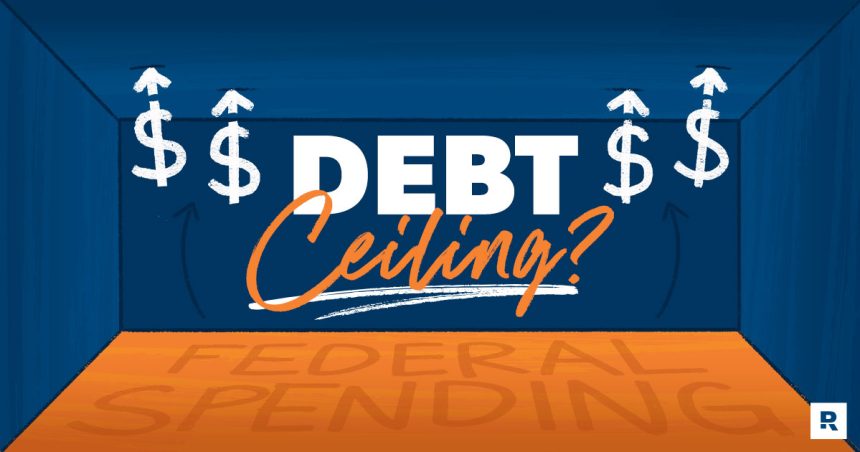Everyone has spending limits—even the government. Believe it or not, though the American government has a habit of spending like it’s going out of style, there’s actually a limit to the amount of debt it can take on. This limit is called the debt ceiling. And since 1960, the government has raised or revised the debt ceiling to borrow more money 78 times.1 (Oh, gee, is that all?)
Each time Congress votes to increase the debt ceiling, sooner or later our national debt goes up too. As of June 2023, the national debt is clocking in at around $32.2 trillion.2 Yuck. Yeah, it’s hard to stomach that many zeros (12, to be exact). But get this: In the last 15 years or so, the national debt has gone up at a crazy fast rate. We’re talking faster than any time since World War II.3 Yup.
So, how does the debt ceiling impact you? Let’s get into everything you need to know about the debt ceiling.
What Is the Debt Ceiling?
The debt ceiling is the limit on how much debt the U.S. government can have. It’s a lot like a credit card limit (shudder) where you’ve been approved for only a certain amount of debt. But instead of American Express setting the limit here, the American government’s spending cap is set by Congress. So it takes a vote by Congress and a passed law before the debt ceiling can be raised.
Why does the government even have to borrow money anyway? Turns out, the money that the government brings in from taxes alone isn’t enough to cover everything. To make up the difference and be able to pay the current bills, the government uses debt.
What’s Happening With the Debt Ceiling Right Now?
On June 3, President Joe Biden signed the Fiscal Responsibility Act (FRA), which suspends the federal debt ceiling until January 1, 2025. Congress could have raised the debt ceiling by a dollar amount, but it decided to suspend it, which means the government can keep accumulating debt for a specific amount of time without hitting the ceiling. When the suspension period ends in 2025, the debt ceiling will be reset to reflect how much additional debt was taken on during the suspension.
“Fiscal responsibility” seems like a strange title for a law that pauses the debt ceiling, but the FRA is supposed to cut federal debt by about $1.5 trillion over the next 10 years.4 Congress passed the FRA after some last-minute negotiations that pushed the U.S. close to defaulting on its debt.
Here’s the backstory: Congress last raised the debt ceiling by $2.5 trillion in December 2021. This made the national debt limit $31.4 trillion.5
Well, the government hit the debt ceiling on January 19, 2023. (Yep, they spend like there’s no tomorrow.) The Treasury Department started using accounting tools called “extraordinary measures” to continue paying the government’s bills. The Treasury’s extraordinary measures include things like shifting money around from different agencies and cutting back on contributions to investment accounts. But these measures only bought time for a few months. If Congress didn’t take action on the debt ceiling by June, we would have had a government shutdown, and the U.S. would have defaulted on its debts. All of that equals bad news for the American economy.
The last time Congress voted to raise the debt ceiling, Democrats controlled the Senate and the House of Representatives, so the bill to increase the debt ceiling passed along party lines. But since Republicans now control the House, increasing the ceiling isn’t as easy.
Taxes don’t have to overwhelm you. See what’s best for your situation—and services you can trust.
Republicans, led by House Speaker Kevin McCarthy, wanted to push through spending cuts to the $6 trillion-plus federal budget in exchange for raising the ceiling. But Biden didn’t really want to budge on spending. In the end, both sides compromised to pass the Fiscal Responsibility Act.
The FRA suspends the debt ceiling for two years (until after the presidential election) and creates limits for discretionary spending. Among other things, the bill cuts money designated for COVID-19 relief (yep, the pandemic is over) and the IRS while providing money for the Department of Veterans Affairs Cost of War Toxic Exposure Fund and the Department of Commerce Nonrecurring Expenses Fund. The FRA also sets a deadline for the student loan payment pause.6
What Happens if the Debt Ceiling Doesn’t Get Raised or Suspended?
So, what would have happened if Congress didn’t raise or suspend the debt ceiling? Is it even that big of a deal?
The short answer? Yup. Here’s why:
If Congress didn’t do anything about the debt ceiling, the U.S. Treasury Department would have stopped paying on Treasury bills, bonds and notes (aka government debt). This would have caused the government to default on its debt. And that’s just the beginning.
Without any money to borrow, the Treasury Department can only pay its bills when your tax money comes in. And if that tax money isn’t enough to cover the bills, then it’s up to the secretary of the Treasury to decide what’s going to get paid—Social Security benefits, federal employee salaries or the big, whopping interest on the grand total of the national debt.
And what about the long-term impact of not raising or suspending the debt ceiling? Well, it’s actually never happened before, so no one knows for sure how bad things would be. But economists say if the government did default on its debt, we’d see the value of cash and stocks tumble, and interest rates would go through the roof (we don’t even want to know what that kind of inflation would look like—yikes!).
Have you noticed a theme here yet? Basically, the government relies on debt to foot the bill for most things (and has for a long time). Debt is the key ingredient it uses to keep the basic functions of our government working. Yeah, it’s pretty ridiculous. The U.S. has dug itself into such a massive hole that it has to keep asking to have its line of credit extended—just so it can keep on spending. Nope, it’s not an episode of The Twilight Zone. It’s just another day in the life of the U.S. government.
What Happens if the Debt Ceiling Does Get Raised?
Well, hooray! The government doesn’t have to default on its debt. But wait . . . that just means it increased its debt limit and can now borrow even more money. Oh, great.
In plain English, once the debt ceiling is raised or suspended, the government can pay its bills, but it can also rack up more debt again. If you’ve ever heard the phrase “spending like you’re in Congress,” this is where it comes from. It’s no secret that government spending is out of control.
What Kind of Debt Does the United States Have?
The American government has two different types of debt to its name—intragovernmental debt and public debt. Nope, the government doesn’t have a credit card it’s racking up stupid airline miles with. Instead, its debt looks like this:
Intragovernmental Debt
Think of this one as what the government owes to itself (ironic, isn’t it?). Things like the Social Security Trust Fund and retirement funds for federal employees fall into this category. So basically, the government has to pay for the essential things it needs to function, but it uses debt against itself to make it happen.
Public Debt
This one is just like it sounds. Public debt is the debt that’s owed to everyone else (like debt we owe to other countries, American banks and investors, etc.) Public debt includes a laundry list of things like Treasury bills, notes and bonds. Most of the debts in the U.S. fall into this public debt group.
Make Sure You Aren’t Adding to Your Own Debt Ceiling
Look, we aren’t going to lie—it makes us mad to see the country going into more and more debt. No one should be happy about that sort of thing. You can yell at Congress while watching C-SPAN on TV all you want, but the truth is—you can’t control what happens in the government. But you can control what you do with the money in your own bank account.
No matter what wacky decisions the government makes, you have the power to be sure the plan for your money is solid. How? By getting on a budget, dumping debt, and making savings a priority. With Financial Peace University, you can learn all about that and more.
At the end of the day, the government is going to do whatever it wants to do. And even though you can’t do much about that, you can get serious about taking care of your money and making sure you’re not raising your own debt ceiling. And who knows? Maybe you’ll even inspire Uncle Sam while you’re at it.
Read the full article here
















